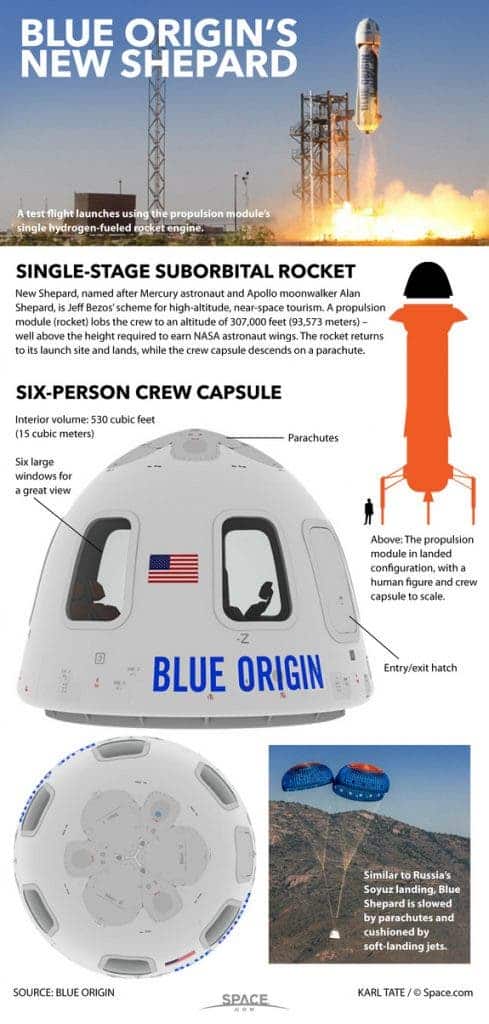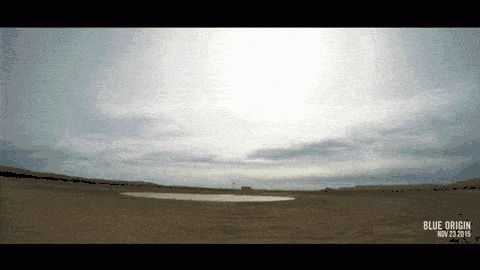Jeff Bezos just announced a historical feat: Blue Origin, his space company, successfully launched its New Shepard rocket to 329,839 feet — or sub-orbital space — then safely landed the used rocket just a feet away from the launch pad. This is the first time a controlled landing was demonstrated for a rocket, beating Elon Musk’s similar efforts to safely land his Falcon 9 rocket. This monumental milestone suggests reusable rockets will shortly become a reality, revolutionizing space flight in the process.
Recycled rockets
When the space shuttle was first designed, its makers intended on building the very first partially reusable craft capable of sending cargo or people into space and then return. The vision was extremely seducing: you launch the craft and then within a few days it would be ready to fly again, greatly reducing cost and thus help spearhead humanity into a truly golden space age. Reality: the shuttle’s turnaround time ended up lasting months instead of days, and the average cost per flight amounted to about US$1.5 billion until 2008 when the program was canceled.
The space shuttle wasn’t a bad idea. The problem with it was that it lacked its own launch system. The shuttle was still dependent on rockets to propel it to dazzling height and velocity to reach orbital space, and like all rockets once these launched they were forever lost, crashing into the desert or ocean. What a waste. You can see now how reusable rockets fit into the picture. Elon Musk, CEO of SpaceX, says that reusable rockets could potentially slice payload costs by 100 fold. Imagine what could happen to the space industry if launches are 100 times cheaper? More sophisticated satellites can be launched more often, as well as cargo and fresh crew to the Internationals Space Station. Space tourism might even turn into a thing, and not just for the rich and powerful – maybe for the middle class, too.

That’s exactly what Blue Origin is after – space tourism. The company’s mission right now is to offer normal people (ok, the rich for now) the “astronaut experience.” It’s recent successful run of New Shepard is a sample taste for what’s to come.
“This flight validates our vehicle architecture and design. Our unique ring fin shifted the center of pressure aft to help control reentry and descent; eight large drag brakes deployed and reduced the vehicle’s terminal speed to 387 mph; hydraulically actuated fins steered the vehicle through 119-mph high-altitude crosswinds to a location precisely aligned with and 5,000 feet above the landing pad; then the highly-throttleable BE-3 engine re-ignited to slow the booster as the landing gear deployed and the vehicle descended the last 100 feet at 4.4 mph to touchdown on the pad,” Bezos wrote in a blog post.
The cinematic production below documents New Shepard’s ascent to sub-orbital space, a simulation of what it would’ve been like if you were inside the detachable capsule, and – of course – the soft landing.
What a fine moment, indeed. But don’t think this one-ups SpaceX, somehow. Yes, the company has repeatedly failed to soft land its Falcon 9 rocket, but this is a different beast entirely. The Falcon 9 is a lot heavier, tests to land it have been made on a mobile ocean platform rather than on land, and like Musk pointed out on twitter, his rocket is designed for orbital flight.
Congrats to Jeff Bezos and the BO team for achieving VTOL on their booster
— Elon Musk (@elonmusk) November 24, 2015
It is, however, important to clear up the difference between “space” and “orbit”, as described well by https://t.co/7PD42m37fZ — Elon Musk (@elonmusk) November 24, 2015
Getting to space needs ~Mach 3, but GTO orbit requires ~Mach 30. The energy needed is the square, i.e. 9 units for space and 900 for orbit.
— Elon Musk (@elonmusk) November 24, 2015
While New Shepherd looks awesome, Bezos says Blue Origin has a new rocket in stored.
“It’s vertical takeoff and vertical landing,” the Amazon founder told a press conference. “It’s a great architecture because it scales to unusually large size. I want you to know, one day, and I don’t know how long this will take, I look forward to having a press conference with you guys in space. I look forward to it very much.







